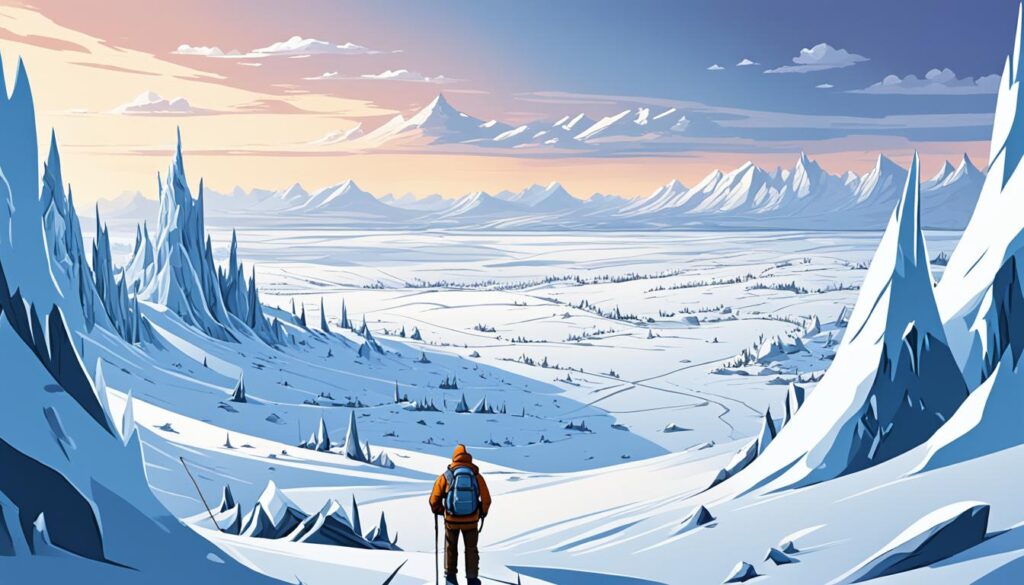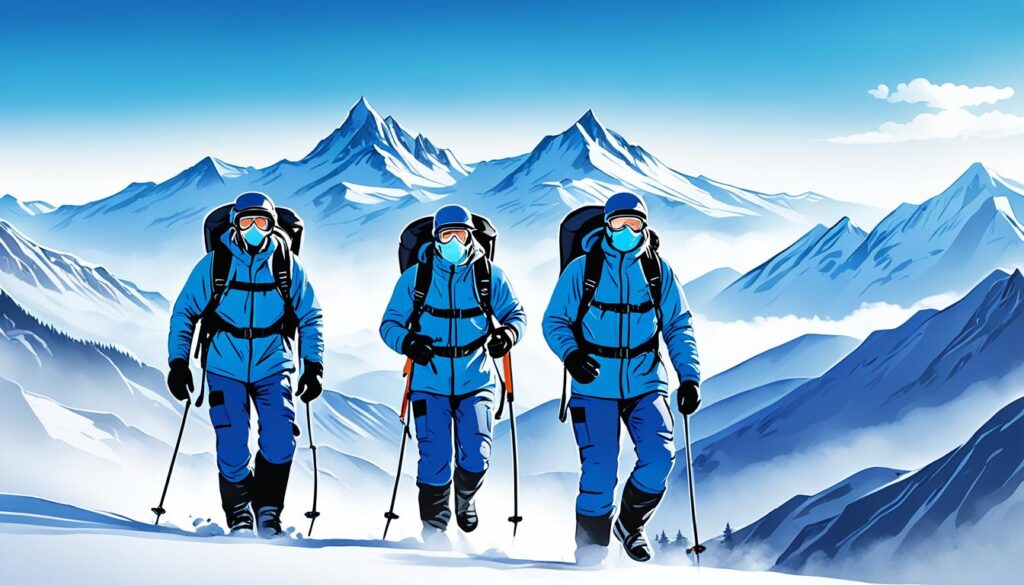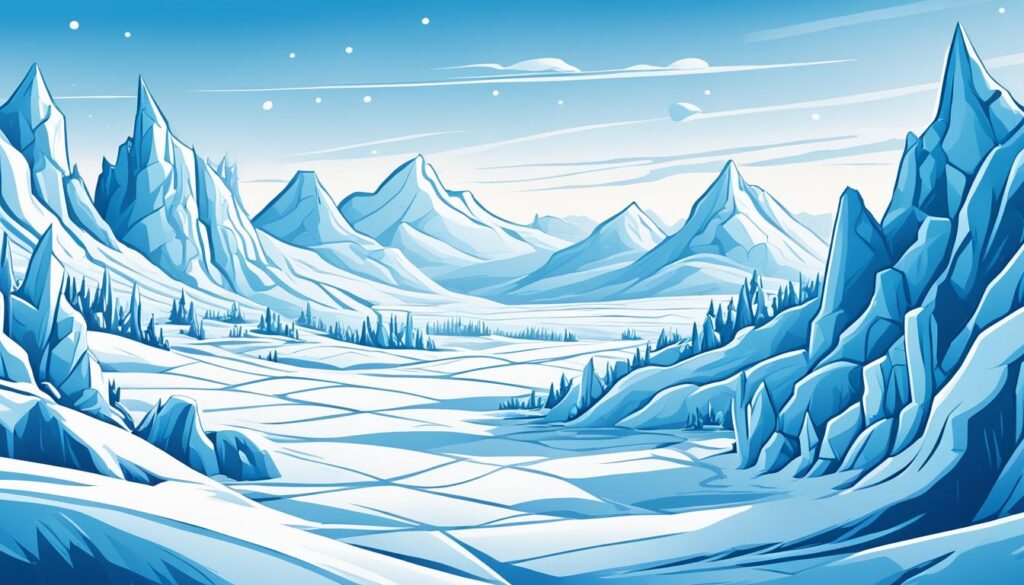Have you ever wondered what it would be like to endure the harshest winter conditions imaginable? While most of us shiver at the thought of stepping out into a bitterly cold day, there are places on Earth where the temperatures plunge to levels that seem almost unimaginable. From the vast, icy expanse of Antarctica to the remote reaches of Siberia, the coldest places on our planet push the limits of human survival and scientific exploration.
What secrets do these extreme environments hold, and what can they teach us about the limits of human endurance and the power of nature? Join me as we uncover the mysteries of the coldest places on Earth, where ordinary thermometers become useless and the human body is tested to its limits.
Key Takeaways
- The coldest places on Earth include Antarctica, Siberia, and parts of North America and the Arctic Circle.
- Temperatures in these regions can plummet to well below freezing, with the coldest ever recorded reaching a bone-chilling -93.2°C (-135.8°F).
- Surviving in these extreme conditions requires specialized clothing, gear, and shelter solutions to protect against the life-threatening effects of the cold.
- Despite the harsh environment, these regions have become hubs of scientific exploration, with researchers studying everything from climate change to astronomy and extreme biomedicine.
- The beauty of these frozen landscapes, from stunning photography to natural phenomena like the Northern Lights, has captivated adventurers and photographers alike.
Introduction
As we delve into the world’s coldest places, it’s important to first define what constitutes extreme cold temperatures. These are the temperatures that push the limits of human endurance and survival, often dipping well below freezing to levels that can be life-threatening within minutes of exposure. In the harshest regions of Antarctica and Siberia, for instance, the mercury can plummet to a bone-chilling -93.2°C (-135.8°F), rendering ordinary thermometers virtually useless.
Defining Extreme Cold Temperatures
Extreme cold temperatures are typically defined as those that fall well below the freezing point of water, 0°C (32°F). In the most extreme environments on Earth, such as the Eastern Antarctic Plateau, temperatures can reach a staggering -98°C (-144.4°F), making these regions some of the coldest natural environments on the planet. These extreme conditions not only challenge the human body’s ability to adapt but also impact the local flora and fauna in profound ways.
Why Explore the Coldest Places on Earth?
Despite the inherent dangers and difficulties of exploring the coldest places, there are numerous reasons why scientists, adventurers, and even tourists are drawn to these inhospitable regions. From conducting groundbreaking climate research to uncovering the secrets of the universe, the world’s coldest environments have become hubs of scientific exploration and discovery. Furthermore, the sheer beauty and otherworldly landscapes of these frozen lands have captivated the imaginations of people around the globe.
The Impact of Climate Change on Extreme Temperatures
As the global climate continues to undergo dramatic changes, the impact of climate change on extreme temperatures is becoming increasingly evident. In many regions, climate models predict that the frequency and intensity of extreme cold events may decrease as the planet warms. However, the relationship between climate change and extreme cold is complex, with some areas potentially experiencing more severe cold spells due to shifts in atmospheric circulation patterns. Understanding the nuances of this dynamic is crucial for preparing for and adapting to the challenges posed by a rapidly changing climate.
The Coldest Places on Earth
While the world’s coldest regions may seem inhospitable and unforgiving, they are also home to some of the most intriguing and scientifically significant locations on the planet. From the vast, icy expanse of the Eastern Antarctic Plateau to the meticulously maintained Vostok Station and the iconic Amundsen-Scott South Pole Station, these coldest places on earth have captured the imagination of adventurers, researchers, and climate scientists alike.
Eastern Antarctic Plateau, Antarctica
The Eastern Antarctic Plateau in Antarctica lays claim to the title of the coldest place on Earth, with satellite data collected between 2004 and 2016 suggesting that air temperatures in this vast, icy expanse could dip as low as -94°C (-137.2°F). Researchers believe that land temperatures in this remote region could even reach a staggering -98°C (-144.4°F), making it the coldest natural environment on the planet.
Vostok Station, Antarctica
Nestled in the heart of Antarctica, the Vostok Station is a research outpost that has witnessed some of the most extreme temperatures recorded in Antarctica. Established in 1957 by the Soviet Union, Vostok has become a hub for climate research, with scientists studying the station’s unique ice core samples to gain insights into the Earth’s past climate and the impact of climate change on extreme temperatures.
Amundsen-Scott Station, Antarctica
Located at the geographic South Pole, the Amundsen-Scott South Pole Station is a year-round research facility operated by the United States Antarctic Program. This iconic station, named after the legendary Norwegian explorer Roald Amundsen and the British explorer Robert Falcon Scott, serves as a hub for a wide range of scientific endeavors, from climate research to astronomy and medical research in extreme environments.
Siberian Freeze: Oymyakon and Verkhoyansk
Nestled deep within the Siberian hinterlands, the remote town of Oymyakon and the village of Verkhoyansk stand as bastions of human resilience against the siberian extreme cold that grips this region. Collectively known as the “Pole of Cold,” these two settlements vying for the title of the coldest inhabited places on Earth, where temperatures can plummet to jaw-dropping lows during the long, polar vortex siberia winters.
Oymyakon, often cited as the coldest inhabited place in the Northern Hemisphere, has recorded temperatures as low as -67.7°C (-90°F) – a figure that seems almost unimaginable. This tiny village, home to just a few hundred hardy souls, sits in a remote valley where the extreme temperatures in siberia are amplified by the siberian high pressure system that dominates the region. Despite the oymyakon russia and verkhoyansk russia residents’ adaptations to this harsh environment, the bone-chilling cold remains a daily challenge.
Verkhoyansk, located just a few hundred kilometers from Oymyakon, has also earned a reputation as one of the coldest inhabited places on the planet. With a record low of -67.8°C (-90°F), this remote Siberian outpost has etched its name into the annals of extreme weather, standing as a testament to the human spirit’s ability to thrive in the face of unforgiving siberian extreme cold.
The sheer tenacity and resilience of the people living in these coldest inhabited places is truly awe-inspiring. In a land where the extreme temperatures in siberia can stop the human body in its tracks, the residents of Oymyakon and Verkhoyansk have developed ingenious strategies to survive and even thrive, showcasing the remarkable adaptability of the human species.
Extreme Cold in North America
While the coldest places on Earth may be found in Antarctica and Siberia, North America is no stranger to extreme cold temperatures. In fact, several regions in the United States and Canada have experienced some of the lowest mercury readings ever recorded, rivaling the icy conditions of the Earth’s polar extremes.
Denali, Alaska
Denali, the highest mountain in North America, is renowned for its harsh, unforgiving climate. During the winter months, temperatures on Denali’s glaciers and peaks can plummet to an astounding -40°C (-40°F) or lower, with wind chills making it feel even colder. This extreme cold, coupled with fierce winds and heavy snowfall, has challenged even the most experienced mountaineers and explorers who have attempted to conquer the summit.
Prospect Creek, Alaska
The small community of Prospect Creek, located in interior Alaska, holds the record for the lowest temperature ever recorded in the United States. On January 23, 1971, the mercury dropped to a bone-chilling -56.7°C (-69.7°F), surpassing the previous record set in Snag, Yukon Territory, Canada. This extreme cold in Prospect Creek is a testament to the unforgiving nature of North America’s extreme cold weather conditions.
Snag, Yukon Territory, Canada
Just across the border in Canada’s Yukon Territory, the village of Snag is another contender for the title of the coldest inhabited place in North America. On February 3, 1947, Snag recorded a jaw-dropping temperature of -63.0°C (-81.4°F), a record that stood for decades and highlighted the extreme cold that can grip the region. The combination of Snag’s high latitude and its location within a cold air mass resulted in these record-breaking temperatures, showcasing the harsh realities of life in one of the coldest corners of the continent.
Arctic Circle Chill: Greenland and Lapland
As we journey further north into the Arctic Circle, we encounter some of the most extreme cold temperatures on the planet. The northernmost regions of the globe, home to Greenland and Lapland in Finland, stand out as particularly frigid locales, where the biting winds and relentless icy landscapes challenge even the hardiest of explorers.
Klinck Station, Greenland
Nestled amidst the vast, frozen expanse of Greenland’s interior, the Klinck Station has long been a hub for scientific research in the extreme cold in the arctic circle. This remote outpost, operated by the Danish Meteorological Institute, has recorded some of the lowest temperatures ever observed in the Northern Hemisphere, with readings dipping as low as -67°C (-88.6°F) during the long, dark winter months.
The greenland cold temperatures pose significant challenges for the researchers and support staff stationed at Klinck, who must contend with the constant threat of frostbite and hypothermia. Yet, their dedication to understanding the region’s arctic climate and weather patterns has yielded invaluable insights into the effects of climate change on these fragile ecosystems.
Lapland, Finland
Further east, in the rugged wilderness of Lapland, Finland, the lapland finland cold temperatures are equally punishing. This vast, subarctic region, known for its stunning northern lights displays and vast, snow-covered landscapes, is home to some of the coldest places in the arctic. The small town of Muonio, for example, has recorded temperatures as low as -51°C (-59.8°F), making it one of the coldest inhabited places in the world.
Despite the challenges posed by the extreme cold in the arctic circle, the people of Lapland have developed a deep appreciation and respect for their harsh, yet beautiful, environment. From traditional reindeer herding to thriving winter tourism, the region’s residents have found ways to not only survive, but to thrive, in the face of some of the most extreme cold temperatures on Earth.
The Science Behind Extreme Temperatures
The science behind extreme cold is a fascinating study of atmospheric conditions, heat transfer, and the unique properties of matter at sub-zero temperatures. Factors such as wind chill, permafrost, and the thermal properties of materials all play a crucial role in understanding how the extreme cold environments of the planet function.
Impact on Human and Animal Life
The impact of extreme cold on humans and animals is profound, as the cold weather effects on living organisms can be severe and far-reaching. From the human body’s physiological responses to the specialized adaptations of Arctic and Antarctic wildlife, the ability to survive and thrive in these harsh conditions is a testament to the resilience of life.

Surviving Extreme Cold
Surviving in the world’s coldest places, where temperatures can plummet to bone-chilling lows, requires specialized clothing and gear as well as strategic shelter and heating solutions. Ensuring your safety and comfort in these extreme cold climates is crucial for navigating the challenges they present.
Clothing and Gear for Extreme Temperatures
Venturing into the freezing temperatures of the coldest regions on Earth demands a thoughtful approach to dressing for the conditions. Layering is key, with a base layer of thermal underwear, followed by insulating mid-layers and a durable, weatherproof outer shell. Investing in high-quality cold weather gear, such as down-filled jackets, snow pants, and insulated boots, can make all the difference in maintaining your body heat and protecting against the elements.
Accessorizing with items like thick socks, gloves, and a warm hat or balaclava is essential for staying warm in these extreme environments. Additionally, specialized equipment like heated insoles, hand warmers, and face masks can provide an extra layer of protection against the biting cold winds and sub-zero temperatures.
Shelter and Heating Solutions
Constructing a suitable shelter is critical for survival in the world’s coldest places. Insulated tents, igloos, or even underground structures can offer crucial protection from the harsh outdoor conditions. Incorporating heating systems, such as portable stoves or generators, can help maintain a livable temperature within your shelter and prevent the risk of hypothermia or frostbite.
In some of the most extreme cold climates, traditional heating methods may not suffice. Exploring alternative solutions, such as geothermal heating or specialized cold-weather heating systems, can provide the necessary warmth and comfort to thrive in these freezing environments.
Scientific Exploration in Extreme Cold
Despite the extreme conditions, the world’s coldest regions have become hubs of scientific exploration and research, with a wide range of disciplines conducting critical work in these inhospitable environments.
Climate Research Stations
In the heart of Antarctica, the Vostok and Amundsen-Scott South Pole Stations serve as vital outposts for climate research, providing invaluable data on the impact of extreme cold on the Earth’s atmosphere and weather patterns. These research stations, located in some of the coldest places on the planet, are at the forefront of our understanding of how climate change is affecting the most frigid corners of the globe.
Astronomical Observatories
The clear, dry air and minimal light pollution of the Arctic and Antarctic regions make them ideal locations for astronomical observatories, where scientists can study the cosmos with unparalleled precision. Facilities like the South Pole Telescope in Antarctica and the IceCube Neutrino Observatory in Greenland are pushing the boundaries of our understanding of the universe, harnessing the unique conditions of these extreme cold environments.
Medical Research in Extreme Environments
The extreme cold of the world’s coldest places also presents unique opportunities for medical research, as scientists investigate how the human body responds to and adapts to such harsh conditions. From studying the effects of hypothermia to exploring the potential therapeutic applications of cryotherapy, researchers are unlocking new insights that could have far-reaching implications for human health and survival.

The Beauty of Frozen Landscapes
While the world’s coldest places may be inhospitable to human life, they are undeniably beautiful, offering a unique and otherworldly landscape that has captivated explorers, scientists, and photographers alike. The icy landscapes of the Arctic and Antarctic regions are a true wonder to behold, with snow-capped peaks, glaciers, and frozen lakes creating a breathtaking winter wonderland.
Stunning Photography of Extreme Cold Regions
Talented photographers have captured the raw beauty of these frozen environments, showcasing the ethereal and ethereal quality of the icy landscapes. From the breathtaking auroras that dance across the night sky to the intricate patterns of frost and ice, these images have the power to transport us to a world of pure, untamed beauty. Whether it’s the serene stillness of a frozen lake or the towering majesty of a glacier, the photography of extreme cold regions is a testament to the awe-inspiring power of nature.
Natural Phenomena in Extreme Cold Environments
Beyond the stunning visuals, the world’s coldest regions are also home to a range of fascinating natural phenomena. The northern lights, or aurora borealis, are a mesmerizing display of colorful lights that can be observed in the Arctic and sub-Arctic regions. The extreme cold also gives rise to unique ice formations, such as the otherworldly “ice flowers” that bloom on the surface of frozen lakes and rivers. These natural wonders serve as a powerful reminder of the incredible diversity of our planet and the resilience of life in even the harshest of environments.
Would you rather explore the world’s hottest places?
I’ve got you covered. Read this article on the hottest places on Earth.



